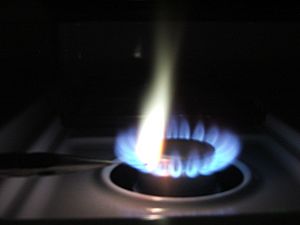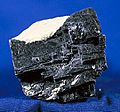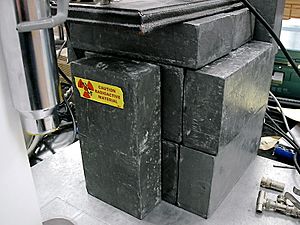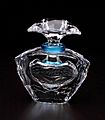Lead facts for kids
Lead (say it like "lehd") is a chemical element. Its special symbol is Pb. This comes from the Latin word plumbum, which means lead. Lead has an atomic number of 82. It is a very heavy metal. It also melts at 327.8°C. Be careful, because lead is very poisonous!
Contents
What Lead Is Like
Physical Features
Lead is a shiny, gray-blue metal. It easily gets dull and turns a flat gray color. It is soft and can be shaped easily. When melted, it becomes very shiny. Lead is also very heavy. It does not rust or wear away easily. Adding other metals like antimony or calcium can make it stronger. Lead is harmful to people and animals if swallowed.
Chemical Features
Lead burns in the air with a grayish-white flame. This creates harmful fumes of lead(II) oxide. Only the surface of lead changes when it touches air. It dissolves in nitric acid to form lead(II) nitrate. However, it does not dissolve in sulfuric acid or hydrochloric acid.
Lead Compounds
Lead can form many different chemical compounds. These compounds are also toxic, just like lead itself. Some lead compounds are used as colors. For example, Lead(IV) oxide is a common lead compound that is black. Other lead compounds can be white or colorless. Lead nitrate and lead(II) acetate are lead compounds that can dissolve in water.
- Lead(II) compounds: These are more common. Most are colorless or white. An example is Lead(II) oxide, which can be red or yellow.
- Lead(IV) compounds: These are less common. They are strong chemicals that can cause other substances to change. An example is Lead(IV) oxide, which is dark brown.
- Mixed compounds: Some compounds have lead in both forms, like Lead(II,IV) oxide, which is red.
Where Lead Is Found
Lead is very rarely found as a pure metal in the Earth's crust. Most often, lead is found in a mineral called galena. Galena is made of lead sulfide. This mineral is the main source from which we get lead.
Lead's History
People have used lead for thousands of years. This is because it is easy to find in the ground and simple to shape. The ancient Romans used lead a lot. They made pipes, drinking cups, and fasteners from it.
How Lead Is Made
Lead is usually made from galena. First, galena is cleaned to remove other materials. Then, the lead sulfide from galena is heated in a furnace. This process turns it into lead(II) oxide. Finally, the lead(II) oxide is heated with coke (a type of fuel) to create liquid lead metal.
How Lead Is Used
As a Metal
Lead is used in the bottom of sailboats to help them stay balanced. It is also used in weight belts for scuba diving. People use lead to make shotgun pellets and bullets. Some old printing presses use lead letters because they are easy to shape. Lead can also be used outdoors because it does not rust in water.
Most lead today is used in lead-acid batteries. These batteries use lead to create electricity. Sheets of lead are also used to block sound in some places. Lead is very good at blocking radiation, so it is used in radiation shielding. Melted lead can even be used to cool down nuclear reactors. It used to be mixed with tin to make pipes for pipe organs, which made different sounds. Lead is also used in solder, which joins metal parts together.
It is used to balance car wheels, make statues, and create decorative parts in buildings.
As Chemical Compounds
Many lead compounds are used to make colored glazes for ceramics. Lead can also be found in some PVC pipes. Lead compounds were once added to candles to help them burn better. Lead glass contains lead(II) oxide. Some lead compounds are still used as pigments (colors) in certain places. Lead compounds were added to gasoline in the past, but this is now against the law. Some lead compounds are used in special devices called photodetectors.
Old Uses of Lead
In the past, lead was used in many red, yellow, and white colors for paints. It was also used in pesticides to kill bugs. Lead used to be in pipes that carried water, but this is no longer allowed. This is because lead can get into the water, which is dangerous.
Safety with Lead
Even though you can safely touch lead, you should avoid being around it too much. Lead is very toxic (poisonous) to humans and other animals if it is swallowed. Because of this, its use is limited in many countries.
If someone is exposed to lead for a long time, it can harm their kidneys and cause stomach pains. Lead also harms the nervous system. In the past, children sometimes ate lead paint and got lead poisoning.
To understand more about lead and its safety, you can read its MSDS.
Related pages
Images for kids
-
The Holsinger meteorite, a large piece of the Canyon Diablo meteorite. Studying lead in this meteorite helped scientists figure out the age of the Earth is about 4.55 billion years old.
See also
 In Spanish: Plomo para niños
In Spanish: Plomo para niños




















